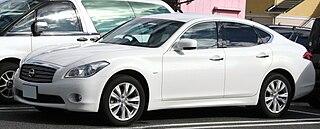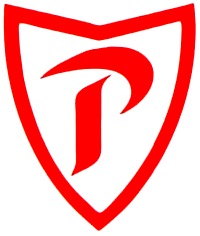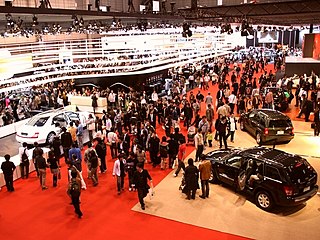
Nissan Motor Co., Ltd., trading as Nissan Motor Corporation and often shortened to Nissan, is a Japanese multinational automobile manufacturer headquartered in Nishi-ku, Yokohama, Japan. The company sells its vehicles under the Nissan and Infiniti brands, and formerly the Datsun brand, with in-house performance tuning products labelled Nismo. The company traces back to the beginnings of the 20th century, with the Nissan zaibatsu, now called Nissan Group.
Power-to-weight ratio is a calculation commonly applied to engines and mobile power sources to enable the comparison of one unit or design to another. Power-to-weight ratio is a measurement of actual performance of any engine or power source. It is also used as a measurement of performance of a vehicle as a whole, with the engine's power output being divided by the weight of the vehicle, to give a metric that is independent of the vehicle's size. Power-to-weight is often quoted by manufacturers at the peak value, but the actual value may vary in use and variations will affect performance.

The Nissan Fuga is a mid-size luxury sedan produced by Japanese automaker Nissan since October 2004. It is built on a wider, stretched wheelbase version of the Nissan FM platform. After the Nissan Cima and Nissan President were discontinued in August 2010, the Fuga became Nissan's flagship vehicle. In North America and Europe, the Fuga is sold as the second and third-generation Infiniti M, where it has been the flagship of the Infiniti luxury division of Nissan since 2006.

The Prince Motor Company was an automobile marque from Japan which eventually merged into Nissan in 1966. It began as the Tachikawa Aircraft Company, a manufacturer of various airplanes for the Japanese Army in World War II, e.g., the Ki-36, Ki-55 and Ki-74. Tachikawa Aircraft Company was dissolved after the war and the company took the name Fuji Precision Industries. It diversified into automobiles, producing an electric car, the Tama, in 1946, named for the region the company originated in, Tama, using the Ohta series PC/PD platform. The company changed its name to Prince in 1952 to honor Akihito's formal investiture as Crown Prince of the nation. In 1954 they changed their name back to Fuji Precision Industries, and in 1961 changed the name back again to Prince Motor Company. In 1966, they became part of Nissan, while the Prince organization remained in existence inside Nissan, as Nissan Prince Store in Japan until Nissan consolidated the Prince dealership network into "Nissan Blue Stage" in 1999.

The International Motor Show Germany or International Mobility Show Germany, in German known as the Internationale Automobil-Ausstellung, is one of the world's largest mobility shows. It consists of two separate fairs, that subdivided in 1991. While the IAA MOBILITY displays passenger vehicles, motorcycles and bikes, the IAA TRANSPORTATION specializes in commercial vehicles. Before the separation, the show was held solely at the Messe Frankfurt.

The Tokyo Motor Show (東京モーターショー) is a biennial auto show held in October–November at the Tokyo Big Sight, Tokyo, Japan for cars, motorcycles and commercial vehicles. Hosted by the Japan Automobile Manufacturers Association (JAMA), it is a recognized international show by the Organisation Internationale des Constructeurs d'Automobiles, and normally sees more concept cars than actual production car introductions which is the reason why the auto press see the show as one of the motorshow's big five.

The Nissan Note is a supermini/subcompact hatchback or a mini MPV manufactured and marketed worldwide by Nissan. Introduced in 2004, the first-generation Note was primarily marketed in Japan and Europe, and was produced in Japan and the United Kingdom. The second-generation model was sold in other regions, including North America where it was manufactured in Mexico and marketed as the Versa Note, and Thailand, where it serves as one of the B-segment hatchback offered by the brand alongside the smaller March under the Eco Car tax scheme.
The Nissan Pivo is a series of electric concept cars created by Nissan, with the first one introduced in 2005 at the Tokyo Motor Show.
Hybrid vehicle drivetrains transmit power to the driving wheels for hybrid vehicles. A hybrid vehicle has multiple forms of motive power.
MIEV or MiEV is the name given by Japanese automaker Mitsubishi Motors (MMC) to its alternative propulsion technologies. From late 2006, “MiEV” encompasses all of Mitsubishi Motors’s electric drive systems work, including lithium-ion batteries, in-wheel motors and other technologies related to electric vehicle (EV), hybrid-electric vehicle and fuel-cell vehicles.

The Nissan Nuvu is a compact all-electric city car with 2+1 seating, with solar panels shaped like tree leaves on the roof that channel the sun's power through a "tree trunk" conduit in the center of the vehicle. The concept car can reach about 75 mph (121 km/h) and travel up to about 80 mi (129 km) on an electric charge.

The Renault Z.E. is a line of all-electric cars from Renault. The line began with the Z.E series of concept cars. The first production car is the Renault Fluence Z.E. that was slated for sales to the public in Israel and Denmark by late 2011 as part of the Better Place network, operated by Renault Fluence ZE cars. In 2011 Renault was awarded a contract to supply 15,600 electric vehicles to the French government and the state-owned postal service, La Poste. The vehicles are to contribute to a planned 25,000 electric vehicle fleet owned by the French government.
Toyota concept vehicles are transportation devices manufactured or designed by automobile company Toyota from 2000 to 2009. As their name suggests, these vehicles were concepts, and, as such, many were never released to dealerships. Many were developed in conjunction with other corporations such as Sony or Subaru.

The Nissan NV200 is a light commercial and leisure activity, 4/5-door van designed and produced by the Japanese automaker Nissan since 2009.

The Nissan Leaf, stylized as LEAF, is a compact five-door hatchback battery electric vehicle (BEV) manufactured by Nissan. It was introduced in Japan and the United States in December 2010, and its second generation was introduced in October 2017. The Leaf's range on a full charge has been increased gradually from 117 km to 364 km, due to the use of a larger battery pack along with several minor improvements.

Nissan Motors has developed several concept cars and limited production electric cars, and launched the series production Nissan Leaf all-electric car in December 2010. As of December 2015, the Leaf is the world's all-time best selling highway-capable plug-in electric car with over 200,000 units sold since its introduction.
This is a list of concept vehicles from Toyota for the years 2010–2019.

The Renault Twizy is a two-seat electric microcar designed and marketed by Renault. It is classified in Europe as either a light or heavy quadricycle depending on the output power, which is either 4 kW (5.4 hp) for the 45 model or 13 kW (17 hp) for the 80 model, both names reflecting its top speed in km/h. Originally manufactured in Valladolid, Spain, production was moved to Busan in South Korea in March 2019 to meet increased demand in Asia.

The Nissan Ariya is a battery electric compact crossover SUV produced by the Japanese automobile manufacturer Nissan. It was introduced in July 2020 as the first battery electric SUV produced by Nissan. It is produced at its Tochigi plant in Japan since January 2022.















